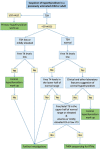The Clinical Spectrum of Resistance to Thyroid Hormone Alpha in Children and Adults
- PMID: 32349464
- PMCID: PMC7947725
- DOI: 10.4274/jcrpe.galenos.2020.2019.0190
The Clinical Spectrum of Resistance to Thyroid Hormone Alpha in Children and Adults
Abstract
Resistance to thyroid hormone alpha occurs due to pathogenic, heterozygous variants in THRA. The entity was first described in 2012 and to date only a small number of patients with varying severity have been reported. In this review, we summarize and interpret the heterogeneous clinical and laboratory features of all published cases, including ours. Many symptoms and findings are similar to those seen in primary hypothyroidism. However, thyroid-stimulating hormone levels are normal. Free triiodothyronine (T3) levels are in the upper half of normal range or frankly high and free thyroxine (T4) levels are low or in the lower half of normal range. Alterations in free T3 and free T4 may not be remarkable, particularly in adults, possibly contributing to underdiagnosis. In such patients, low reverse T3 levels, normo- or macrocytic anemia or, particularly in children, mildly elevated creatine kinase levels would warrant THRA sequencing. Treatment with L-thyroxine results in improvement of some clinical findings.
Keywords: Constipation; LT4; autism spectrum disorder; central hypothyroidism; developmental delay; growth failure; impaired sensitivity to thyroid hormone.
Figures




References
-
- Visser TJ. Regulation of thyroid function, synthesis and function of thyroid hormones. In: Vitti P, Hegedus L (Eds). Thyroid Diseases Endocrinology. Springer, Cham. 2018:1–30.
-
- Horlein AJ, Heinzel T, Rosenfeld MG. Gene regulation by thyroid hormone receptors. Curr Opin Endocrinol Diabetes. 1996;3:412–416.
Publication types
MeSH terms
Substances
LinkOut - more resources
Full Text Sources
Other Literature Sources
Medical
